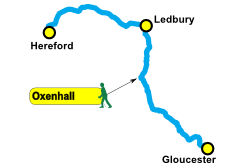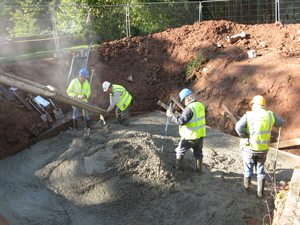The Bailey Bridge has been a useful and safe way to cross Ell Brook Aqueduct whilst the initial work on the aqueduct was completed.

 The removal was undertaken by the Royal Monmouthshire Engineers, who saw the activity as a useful training exercise. The task was to lift off the deck of the Bailey bridge, preparing the crane platform and then lifting the bridge to a new level platform in our compound.
The removal was undertaken by the Royal Monmouthshire Engineers, who saw the activity as a useful training exercise. The task was to lift off the deck of the Bailey bridge, preparing the crane platform and then lifting the bridge to a new level platform in our compound.
Their first task was to secure delivery of three lorry loads of hardcore to provide firm access and parking for the large crane which came a couple of days later. Before that the soldiers had to remove all the decking plates from the bridge to make it as light as possible, and each one was a six-man lift – certainly not a job for the senior citizen volunteers of the Canal Trust. Each plate was carried about 100 yards, to be close to the final resting place of the bridge, and there were 35 altogether although some were only a four-man lift!
 The bridge lift went roughly to plan with a hired crane from Sparrows passing easily through the new gate recently installed. The crane driver had been told to expect to lift a weight of about 5 tons with all the decking removed but it turned out to be nearer 7 tons which meant the crane had to move twice more, moving the bridge a little each time, in order to drop the bridge safely in its final resting place without the whole lot toppling over. The decking plates were finally stacked on the bridge in a tidy pile.
The bridge lift went roughly to plan with a hired crane from Sparrows passing easily through the new gate recently installed. The crane driver had been told to expect to lift a weight of about 5 tons with all the decking removed but it turned out to be nearer 7 tons which meant the crane had to move twice more, moving the bridge a little each time, in order to drop the bridge safely in its final resting place without the whole lot toppling over. The decking plates were finally stacked on the bridge in a tidy pile.
Digging down to the Aqueduct
The space now revealed under the Bailey Bridge contained several tons of soil which had to be removed before we could get at the aqueduct underneath to complete the repairs. So the following Tuesday saw the arrival of an excavator with diver who spent the day moving this soil to one side revealing the top of the stonework comprising the arch of the aqueduct. With his skilful use of the excavator controls he skimmed off all but the final inch of soil which the volunteers spent the following two Tuesdays removing with buckets and trowels. This final scrape revealed the reason why we were doing this work. The old stonework, which is over 200 years old, had been patched up over the years but in a couple of places our trowels found small holes where stones had fallen out and great care had to be taken not to make the damage any worse and collapse part of the arch. A temporary plug of concrete was inserted supported by emergency shuttering underneath and with fingers crossed the cleaning was done. Finally a bit of shuttering to contain the concrete and we were ready for the final phase.
Pouring the concrete
 Initial calculations indicated that about 14 cubic metres of concrete weighing about 20 tons would be required to give a substantial protective membrane over the old aqueduct arch. The largest lorry only carries about 8 cubic metres so a morning delivery was made and there was plenty of time to spread the load evenly and lay reinforcing wire on top ready for the second delivery in the afternoon.
Initial calculations indicated that about 14 cubic metres of concrete weighing about 20 tons would be required to give a substantial protective membrane over the old aqueduct arch. The largest lorry only carries about 8 cubic metres so a morning delivery was made and there was plenty of time to spread the load evenly and lay reinforcing wire on top ready for the second delivery in the afternoon.
This too was achieved, the arch was still standing, and the total volume of concrete came to 13.5 cubic metres. Rakes and shovels were used to spread the wet concrete evenly over the whole arch and a final smoothing off with the back of a shovel prepared the top for a coat of waterproofing compound when the concrete is dry next week. A long day but four very tired volunteers went home quite satisfied at the end of it all.
[envira-gallery id=”3702″]




